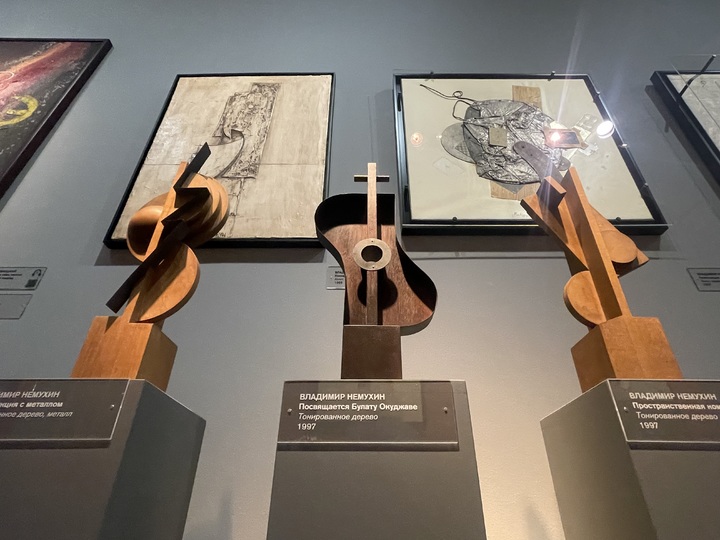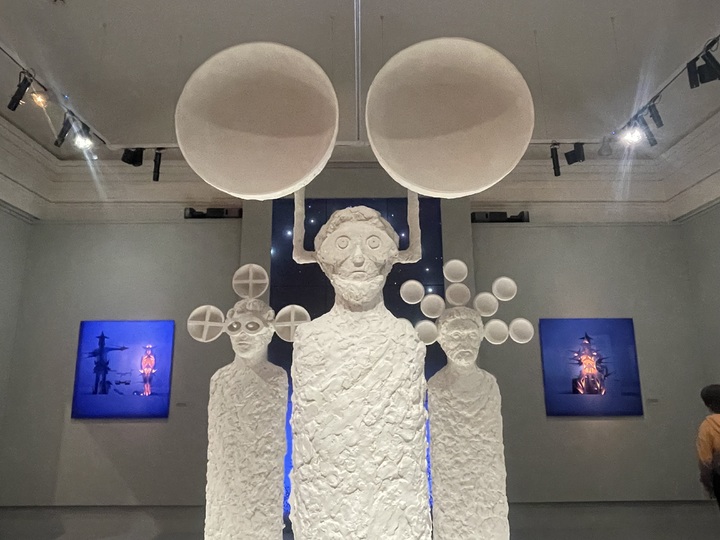Parallel universes converged in the Russian Museum
[ad_1]
“Parallel Universes. From Abstraction to Artifact” – this is the name of a large-scale exhibition in the Marble Palace of the Russian Museum, which presents 220 works by 36 nonconformist artists. The name of the project has a double meaning: on the one hand, unofficial art was that very other universe that existed in Soviet times in parallel with official socialist realism. On the other hand, among the authors of works that did not correspond to the accepted canon, each of the artists lived in his own world. What the Universe of nonconformist galaxies turned out to be, the MK columnist estimated.
The exhibition of the best works from the collection of Natalia Opaleva begins with the film Black Square by Olga Sviblova, filmed together with director Joseph Pasternak back in 1992. The motion picture appeared at the very moment when it finally became possible to speak freely about the so-called “other art”. The starting point here is the most famous work of Kazimir Malevich, which divided the history of art into “before” and “after”. In the 1930s, Suprematism, like the entire avant-garde, was explained by formalism and deleted from official history. However, a generation later, it turned out that the “Black Square” was not forgotten – during the years of the “thaw”, the so-called second wave of avant-garde began to raise its head, hidden in the sand for several decades. Exhibition of avant-garde artists in the Moscow Manege in 1962, Bulldozer exhibition (1974), vernissage in Izmailovo (two weeks after the dispersal in Belyaevo), exhibitions of the painting section at the City Committee of Graphics on Malaya Gruzinskaya (1977): the further, the clearer it became that nonconformists – it is a powerful and versatile phenomenon of its time. Much later it will be called the “Soviet Renaissance”. These authors, one way or another, each in their own way, engaged in a dialogue with the artists of the early twentieth century. The film “Black Square” begins just with a quote from a letter from Eduard Steinberg addressed to Malevich, where he writes: “Thank fate that you were at the beginning of a new story, and not at the end of it, when the Black Square became an embodied reality.”
This image – a square as a kind of failure and at the same time a portal from one universe to another – runs like a red thread through the entire exhibition. It begins with an installation by Plato Infante, the son of the famous 1960s artist Francisco Infante. Before us are two white square-windows against the background of red walls, parallel black lines stretch from one to the other, which “at the entrance” to the portals begin to twist, twist into a knot, and tear. From here, the viewer enters the first hall through the “red square” – the entrance to each next section will also pass through such a Suprematist portal-frame, on which the names of the authors whose works are presented here are inscribed.

In the first room, where the works of Anatoly Zverev, Dmitry Plavinsky, Vladimir Nemukhin are exhibited, there is another portal, now black and white. The central space is occupied by an installation of two false walls, on the inside of which there are screens, where fragments of nonconformist paintings flicker among moving black and white lines. An elongated “Black Square” is outlined on the floor between the minis – it is glossy, so it becomes a vague reflection of the screens and you personally.
In such an environment of parallel universes, the works of artists coexist, who communicated and made friends, but each created his own art. Anatoly Zverev was a master of the moment – in a few seconds he could write an incredibly lively, light, flying portrait, landscape or abstraction on a sheet. Dmitry Plavinsky worked long and hard on each work. He weaves mysterious symbols and signs, history and culture of different eras into his textured reliefs. Vladimir Nemukhin revived the Dadaist collage genre in Soviet Russia: on his canvases, playing cards are combined with abstract painting and everyday details (like whips, cigarette butts, cans) into an allegorical picture of life.
Each subsequent room shows how different nonconformist artists were. Petr Belelok, who was born near Chernobyl, created collage paintings where people find themselves in a whirlwind of disaster. They are reminiscent of black and white dreams of the apocalypse. Alexander Ney made sculptures from terracotta, dotted with unusual patterns, as if they were made by the master of some ancient forgotten civilization. Oleg Tselkov tore off the mask from humanity – he painted one-faced people with the utmost sincerity, simplifying the means of expression and filling them with multidimensional meanings. Leonid Purygin created fantastic characters in the spirit of the old Russian lubok and surrealism at the same time. His paintings are reminiscent of fairy tales, where winged giraffe people, space snails with female faces, flying deities with bird paws live…

The universes of each of the artists require immersion and comprehension – each has his own visual language, symbolic or figurative system, his own philosophy. But something unites them all. And not only that they fell out of the official doctrine. Firstly, despite their innovative methods, they all somehow started from traditions and looked into the past in order to find the truth there, rethink it, pass it through themselves and transform it into their own vision. The idea that non-conformists are not going to break the old in order to build a new one, but quite the contrary, sounds from the lips of many artists in the film “Black Square”. And secondly, the emphasis of the exhibition is on abstract art, through which all nonconformists went through, even if in the end they created quite figurative things.
Now most of the sixties are no longer alive, but these documentary shots confirm what an attentive viewer can already read in their works. That is why the expression “Soviet Renaissance” is quite logical and adequate to refer to the art of that era (the core of the exhibition is the work of the 1960-80s). The experience of the avant-garde of the early twentieth century allowed the sixties, who grew up in the coordinate system of “understandable and accessible art”, to realize that it is different and go beyond the established canon. There is not only social realism, there was Malevich, Kandinsky, Tatlin, etc. As many authors admit in the already mentioned film by Olga Sviblova, it seemed to them that they exist in a kind of “black hole”, in a void where the “Black Square” became a reality. But, as it turned out, sometimes a black hole can become a portal to a parallel world. At the exhibition, the viewer constantly passes through such gates, discovering an unexpected fact in each of the seven halls: the “Black Square” was not the point at which art ended, but the beginning of a new one, where through abstraction there was an appeal to history, a revival of interest in artifacts, details , decorative elements, behind which there is a deep philosophy. Not always clear to the eye, but perceived on an intuitive level, exciting the imagination and mind.
[ad_2]
Source link






